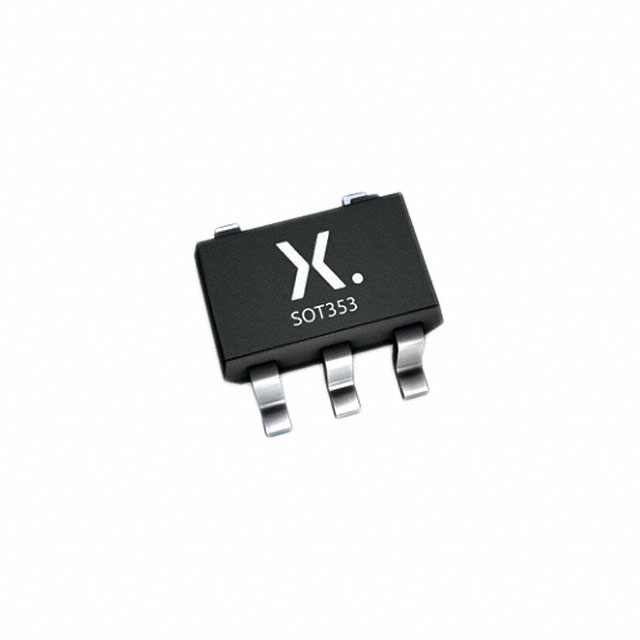Encyclopedia Entry: 74AHCT1G14GW,165
Product Overview
Category
The 74AHCT1G14GW,165 belongs to the category of integrated circuits (ICs). Specifically, it falls under the category of logic gates.
Use
This product is commonly used in digital electronic circuits for signal processing and logical operations. It serves as an inverter gate, which means it can convert a logic level from high to low or vice versa.
Characteristics
- High-speed operation: The 74AHCT1G14GW,165 is designed to operate at high speeds, making it suitable for applications that require quick response times.
- Low power consumption: This IC is known for its low power consumption, making it energy-efficient and ideal for battery-powered devices.
- Wide operating voltage range: It can operate within a wide voltage range, typically between 2V and 5.5V, allowing for compatibility with various systems.
- Small package size: The 74AHCT1G14GW,165 comes in a small SOT-353 package, which makes it suitable for space-constrained applications.
Package and Quantity
The 74AHCT1G14GW,165 is available in a surface-mount package. It is commonly sold in reels or tape and reel packaging, with a typical quantity of 3000 units per reel.
Specifications
- Supply Voltage Range: 2V to 5.5V
- Input Voltage Range: 0V to VCC
- Output Voltage Range: 0V to VCC
- Operating Temperature Range: -40°C to +85°C
- Propagation Delay: 4 ns (typical)
- Input Capacitance: 3 pF (typical)
- Output Current: ±8 mA
Pin Configuration
The 74AHCT1G14GW,165 has a total of 5 pins, as follows:
____
A --| |-- VCC
B --| |-- Y
GND --|____|-- NC
- A: Input pin for the logic signal.
- B: Input pin for the complementary logic signal.
- VCC: Power supply pin (+2V to +5.5V).
- Y: Output pin for the inverted logic signal.
- GND: Ground pin (0V reference).
- NC: Not connected pin.
Functional Features
The 74AHCT1G14GW,165 is designed to perform the following functions:
- Inversion: It takes the input signal and produces its logical complement at the output pin.
- Signal amplification: The IC can amplify weak input signals to a higher voltage level, ensuring reliable signal transmission.
Advantages and Disadvantages
Advantages
- High-speed operation enables quick response times in digital circuits.
- Low power consumption makes it suitable for energy-efficient applications.
- Wide operating voltage range allows compatibility with various systems.
- Small package size facilitates use in space-constrained designs.
Disadvantages
- Limited functionality: The 74AHCT1G14GW,165 is an inverter gate and cannot perform other logical operations.
- Single-channel design: It can process only one input signal at a time.
Working Principles
The 74AHCT1G14GW,165 operates based on the principles of complementary metal-oxide-semiconductor (CMOS) technology. It utilizes a combination of NMOS (N-type metal-oxide-semiconductor) and PMOS (P-type metal-oxide-semiconductor) transistors to achieve the desired logic inversion function.
When the input signal is high, the NMOS transistor conducts, allowing current to flow from the power supply (VCC) to the output pin (Y). Simultaneously, the PMOS transistor is turned off, preventing current flow to ground (GND). This results in a low logic level at the output.
Conversely, when the input signal is low, the NMOS transistor is turned off, blocking current flow to the output pin. At the same time, the PMOS transistor conducts, providing a path for current to flow from VCC to GND. As a result, a high logic level is produced at the output.
Detailed Application Field Plans
The 74AHCT1G14GW,165 finds applications in various fields, including:
- Digital electronics: It is widely used in digital circuits, such as microcontrollers, CPUs, and memory systems, for logical operations and signal processing.
- Communication systems: The IC can be employed in communication devices, such as routers, switches, and modems, to handle signal inversion and amplification.
- Consumer electronics: It is utilized in devices like smartphones, tablets, and gaming consoles for signal conversion and voltage level shifting.
- Automotive industry: The product is suitable for automotive applications, including engine control units,
Senaraikan 10 soalan dan jawapan biasa yang berkaitan dengan aplikasi 74AHCT1G14GW,165 dalam penyelesaian teknikal
Sure! Here are 10 common questions and answers related to the application of 74AHCT1G14GW,165 in technical solutions:
Q1: What is the 74AHCT1G14GW,165? A1: The 74AHCT1G14GW,165 is a single Schmitt-trigger inverter IC (integrated circuit) that can be used in various electronic applications.
Q2: What is the purpose of a Schmitt-trigger inverter? A2: A Schmitt-trigger inverter is used to convert an input signal with slow transitions into a clean digital output signal with well-defined voltage levels.
Q3: What is the operating voltage range of the 74AHCT1G14GW,165? A3: The 74AHCT1G14GW,165 operates within a voltage range of 4.5V to 5.5V.
Q4: Can the 74AHCT1G14GW,165 handle high-speed signals? A4: Yes, the 74AHCT1G14GW,165 is designed to handle high-speed signals with fast propagation delays.
Q5: How many inputs does the 74AHCT1G14GW,165 have? A5: The 74AHCT1G14GW,165 has one input pin.
Q6: What is the output logic level of the 74AHCT1G14GW,165? A6: The output logic level of the 74AHCT1G14GW,165 is compatible with both CMOS and TTL logic families.
Q7: Can the 74AHCT1G14GW,165 be used for level shifting? A7: Yes, the 74AHCT1G14GW,165 can be used for level shifting between different voltage domains.
Q8: What is the maximum output current of the 74AHCT1G14GW,165? A8: The 74AHCT1G14GW,165 can provide a maximum output current of around 8mA.
Q9: Is the 74AHCT1G14GW,165 suitable for battery-powered applications? A9: Yes, the 74AHCT1G14GW,165 is suitable for battery-powered applications due to its low power consumption.
Q10: Can the 74AHCT1G14GW,165 be used in temperature-sensitive environments? A10: Yes, the 74AHCT1G14GW,165 has a wide operating temperature range and can be used in temperature-sensitive environments.
Please note that these answers are general and may vary depending on specific application requirements.


